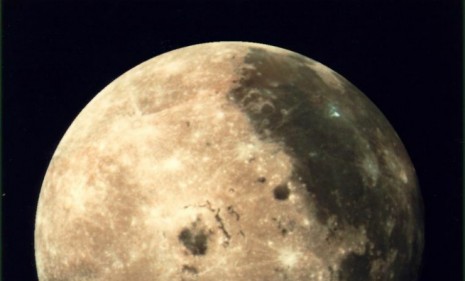The gigantic underground moon cave
Indian scientists have uncovered a cavern on the moon big enough to be a home base for human voyagers. Is this a game-changer for space exploration?

India's space agency announced it had discovered an enormous volcanic cave under the surface of the moon, in the midst of analyzing 3D images taken last year by the lunar orbiter Chandrayaan-1. Thanks in large part to its stable climate, the cave could provide suitable housing for humans who want to further explore the moon. Here's a brief guide to this groundbreaking discovery:
How big is this thing?
The cave, which was formed from "ancient volcanic lava flows," is more than one mile long and 393 feet wide — big enough to "contain a small lunar city or a secret Nazi base with a few thousand UFOs," says Jesus Diaz at Gizmodo. It's far bigger than what was previously the largest-known hole on the moon, which is 213 feet across and 289 feet deep, and was discovered by the Japanese Space agency Jaxa in 2009.
The Week
Escape your echo chamber. Get the facts behind the news, plus analysis from multiple perspectives.

Sign up for The Week's Free Newsletters
From our morning news briefing to a weekly Good News Newsletter, get the best of The Week delivered directly to your inbox.
From our morning news briefing to a weekly Good News Newsletter, get the best of The Week delivered directly to your inbox.
Why is it so good for humans?
Its main attraction is a temperate climate. Temperatures on the moon swing wildly, from a maximum of 262 degrees Fahrenheit to a minimum of -292. The cave holds steady at a (relatively) comfortable -4, since the moon's weather can't penetrate its 40-foot-thick wall. It could also protect astronauts from "hazardous radiations, micro-meteoritic impacts," and dust storms, according to paper published by the journal Current Science, as quoted by Silicon India.
So when are we moving in?
Though there has been a recent surge of interest in exploring the moon, "scientists caution that it would be unrealistic to expect any long-term habitation efforts within the next two decades," says G.S. Mudur at the Indian newspaper The Telegraph. Some observers aren't pleased with that assessment. "What's the holdup?" says Adam Frucci at DVice. "Let's get building! I want to visit a hotel in a moon base sometime in the next 20 years, please!"
A free daily email with the biggest news stories of the day – and the best features from TheWeek.com
Sources: Gizmodo, DVice, The Telegraph, Silicon India
-
 Hegseth rejects release of full boat strike footage
Hegseth rejects release of full boat strike footageSpeed Read There are calls to release video of the military killing two survivors of a Sept. 2 missile strike on an alleged drug trafficking boat
-
 ‘It’s another clarifying moment in our age of moral collapse’
‘It’s another clarifying moment in our age of moral collapse’Instant Opinion Opinion, comment and editorials of the day
-
 Trump vows naval blockade of most Venezuelan oil
Trump vows naval blockade of most Venezuelan oilSpeed Read The announcement further escalates pressure on President Nicolás Maduro